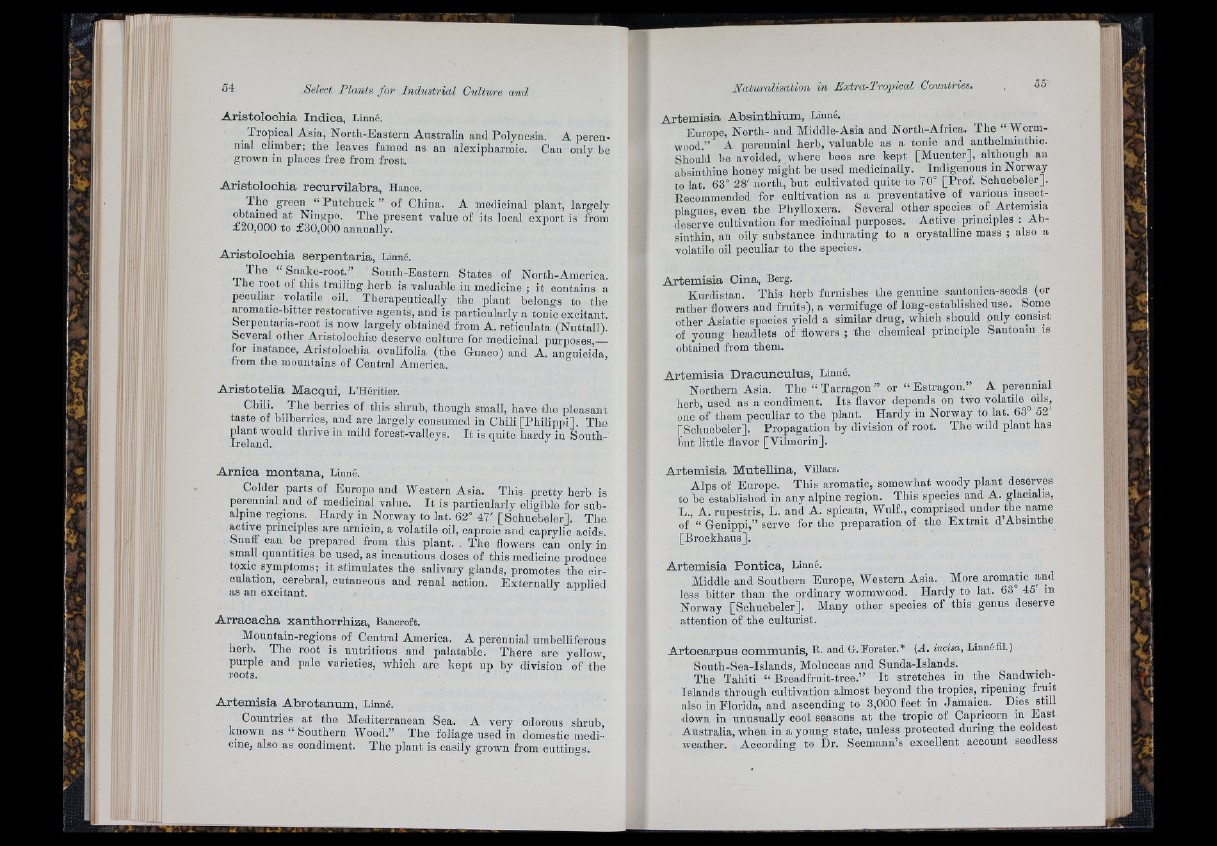
A ris to lo c h ia In d ic a , Linné.
^ Tropical Asia, North-Eastern Australia and Polynesia. A perennial
climber; the leaves famed as an alexipliarmic. Can only be
grown in places free from frost.
A ris to lo c h ia re c u rv ila b ra , Hance.
The green “ Putohuok ” of China. A medicinal plant, largely
obtained a t Ningpo. The present value of its local export is from
£20,000 to £30,000 annually.
A ris to lo c h ia s e rp e n ta r ia , Linné.
The “ Snake-root.” South-Eastern States of North-America.
The root of this trailing herb is valuable in medicine ; it contains a
peculiar volatile oil. Therapeutically the plant belongs to the
aromatic-bitter restorative agents, and is particularly a tonic excitant.
Serpentana-root is now largely obtained from A. reticulata (Nuttall).
Several other Aristolochiæ deserve culture for medicinal purposes,—
for instance, Aristolochia ovalifolia (the Guaco) and A. anguicida,
from the mountains of Centra] America.
A r is to te lia Mao q u i, L ’Héritier.
Chili. The berries of this shrub, though small, have the pleasant
taste of bilberries, and are largely consumed in Chili [Philippi]. The
plant would thrive in mild forest-valleys. I t is quite hardy in South-
Ireland.
A rn ic a m o n ta n a , Linné.
Colder parts of Europe and Western Asia. This pretty herb is
perennial and of medicinal value. I t is particularly eligible for subalpine
regions. Hardy in Norway to lat. 62° 47' [Schuebeler]. The
active principles are arnicin, a volatile oil, caproic and caprylic acids
Snuff can be prepared from this plant. , The flowers can only in
small quantities be used, as incautious doses of this medicine produce
toxic symptoms; it stimulates the salivary glands, promotes the circulation,
cerebral, cutaneous and renal action. Externally applied
as an excitant.
A r r a c a c h a x a n th o r rh iz a , Bancroft.
Mountain-regions of Central America. A perennial umbelliferous
herb. The root is nutritious and palatable. There are yellow,
purple and pale varieties, which are kept up by division of the
roots.
A r tem is ia A b ro ta n um , Linné.
Countries a t the Mediterranean Sea. A very odorous shrub,
known as “ Soutlaern Wood.” The foliage used in domestic medicine,
also as condiment. The plant is easily grown from cuttings.
A rtem is ia A b s in th ium , Linné.
Europe, North- and Middle-Asia and North-Africa. The “ Wormwood.”
A perennial herb, valuable as a tonic and anthelmiiithic.
Should be avoided, where bees are kept [Muenter], although an
absinthine honey might be used medicinally. Indigenous in Norway
to lat. 63° 28' north, but cultivated quite to 70° [Prof. Schuebeler].
Recommended for cultivation as a preventative of various insect-
plagues, even the Phylloxera. Several other species ^ of Artemisia
deserve cultivation for medicinal purposes. Active principles : Ab-
sinthin, an oily substance indurating to a crystalline mass ; also a
volatile oil peculiar to the species.
A rtem is ia Cina, Berg.
Kurdistan. This herb furnislies the genuine santonica-seeds (or
rather flowers and fruits), a vermifuge of long-established use. Some
other Asiatic species yield a similar drug, wliioh should only consist
of young headlets of flowers ; the chemical principle Santonin is
obtained from them.
A rtem is ia D ra o u n c u lu s , Linné.
Northern Asia. The “ Tarragon ” or “ E stragon.” A perennial
herb, used as a condiment. Its flavor depends on two volatile ^oils,
one of them peculiar to the plant. Hardy in Norway to lat. 63° 52
[Schuebeler]. Propagation by division of root. The wild plant has
init little flavor [Vilmorin].
A rtem is ia M u te llin a , Villars.
Alps of Europe. This aromatic, somewhat woody plant deserves
to be establislied in any alpine region. This species and A. glacialis,
L., A. rupestris, L. and A. spicata, Wulf., comprised under the name
of “ Genippi,” serve for the preparation of the E x tra it d’Ahsinthe
[Brockhaus].
A rtem is ia P o n tic a , Linné.
Middle and Southern Europe, Western Asia. More aromatic and
less hitter than the ordinary wormwood. Hardy to lat. 63 45 in
Norway [Schuebeler]. Many other species of this genus deserve
attention of the culturist.
A r to c a rp u s COramunis, and U. Forster.* mcisct, Linné fil.)
South-Sea-Islands, Moluccas and Sunda-Islands. _
The Tahiti “ Breadfruit-tree.” I t stretches in the Sandwioh-
Islands through cultivation almost beyond the tropics, ripening fruit
also in Florida, and ascending to 3,000 feet in Jamaica. Dies still
down in unusually cool seasons a t the tropic of Capricorn in East
Australia, when in a young state, unless protected during the coldest
weather. According to Dr. Seemann’s excellent account seedless